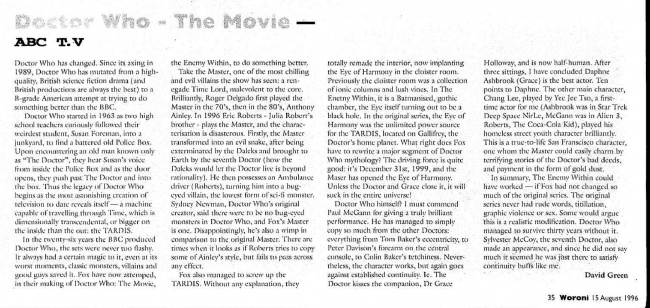Doctor Who has changed
- Publication: Woroni
- Date: 1996-08-15
- Author: David Green
- Page: 35
- Language: English
Doctor Who has changed. Since its axing in 1989, Doctor Who has mutated from a high quality, British science fiction drama (and British productions are always the best) to a B-grade American attempt at trying to do something better than the BBC.
Doctor Who started in 1963 as two high school teachers curiously followed their weirdest student, Susan Foreman, into a junkyard, to find a battered old Police Box. Upon encountering an old man known only as 'The Doctor', they hear Susan's voice from inside the Police Box and as the door opens, they push past The Doctor and into the box. Thus the legacy of Doctor Who begins as the most astonishing creation of television to date reveals itself — a machine capable of travelling through Time, which is dimensionally transcendental, or bigger on the inside than the out: the TARDIS. In the twenty-six years the BBC produced Doctor Who, the sets were never too flashy. It always had a certain magic to it, even at its worst moments, classic monsters, villains and good guys saved it. Fox have now attemped, in their making of Doctor Who: The Movie, the Enemy Within, to do something better.
Take the Master, one of the most chilling and evil villains the show has seen: a renegade Time Lord, malevolent to the core. Brilliantly, Roger Delgado first played the Master in the 70's, then in the 80's, Anthony Ainley. In 1996 Eric Roberts - Julia Robert's brother - plays the Master, and the characterisation is disasterous. Firstly, the Master transformed into an evil snake, after being exterminated by the Daleks and brought to Earth by the seventh Doctor (how the Daleks would let the Doctor live is beyond rationality). Ho then possesses an Ambulance driver (Roberts), turning him into a bug eyed villain, the lowest form of sci-fi monster. Sydney Newman, Doctor Who's original creator, said there were to be no bug-eyed monsters in Doctor Who, and Fox's Master is one. Disappointingly, he's also a wimp in comparison to the original Master. There are times when it looks as if Roberts tries to copy some of Ainley's style, but fails to pass across any effect.
Fox also managed to screw up the TARDIS. Without any explanation, they totally remade the interior, now implanting the Eye of Harmony in the cloister room. Previously the cloister room was a collection of ionic columns and lush vines. In The Enemy Within, it is a Batmanised, gothic chamber, the Eye itself turning out to be a black hole. In the original series, the Eye of Harmony was the unlimited power source for the TARDIS, located on Gallifrey, the Doctor's home planet. What right does Fox have to rewrite a major segment of Doctor Who mythology? The driving force is quite good: it's December 31st, 1999, and the Maser has opened the Eye of Harmony. Unless the Doctor and Grace close it, it will suck in the entire universe!
Doctor Who himself? I must commend Paul McGann for giving a truly brilliant performance. He has managed to simply copy so much from the other Doctors: everything from Tom Baker's eccentricity, to Peter Davison's forearm on the central console, to Colin Baker's tetchiness. Nevertheless, the character works, but again goes against established continuity. Ie. The Doctor kisses the companion, Dr Grace Holloway, and is now half-human. After three sittings, I have concluded Daphne Ashbrook (Grace) is the best actor. Ten points to Daphne. The other main character, Chang Lee, played by Yee Jee Tso, a first time actor for me (Ashbrook was in Star Trek Deep Space Nine, McGann was in Alien 3, Roberts, The Coca-Cola Kid), played his homeless street youth character brilliantly. This is a true-to-life San Franscisco character, one whom the Master could easily charm by terrifying stories of the Doctor's bad deeds, and payment in the form of gold dust.
In summary, The Enemy Within could have worked — if Fox had not changed so much of the original series. The original series never had rude words, titillation, graphic violence or sex. Some would argue this is a realistic modification. Doctor Who managed to survive thirty years without it. Sylvester McCoy, the seventh Doctor, also made an appearance, and since he did not say much it seemed he was just there to satisfy continuity buffs like me.
Spelling corrections: Julia Roberts, San Francisco
Disclaimer: These citations are created on-the-fly using primitive parsing techniques. You should double-check all citations. Send feedback to whovian@cuttingsarchive.org
- APA 6th ed.: Green, David (1996-08-15). Doctor Who has changed. Woroni p. 35.
- MLA 7th ed.: Green, David. "Doctor Who has changed." Woroni [add city] 1996-08-15, 35. Print.
- Chicago 15th ed.: Green, David. "Doctor Who has changed." Woroni, edition, sec., 1996-08-15
- Turabian: Green, David. "Doctor Who has changed." Woroni, 1996-08-15, section, 35 edition.
- Wikipedia (this article): <ref>{{cite news| title=Doctor Who has changed | url=http://cuttingsarchive.org/index.php/Doctor_Who_has_changed | work=Woroni | pages=35 | date=1996-08-15 | via=Doctor Who Cuttings Archive | accessdate=29 June 2025 }}</ref>
- Wikipedia (this page): <ref>{{cite web | title=Doctor Who has changed | url=http://cuttingsarchive.org/index.php/Doctor_Who_has_changed | work=Doctor Who Cuttings Archive | accessdate=29 June 2025}}</ref>
